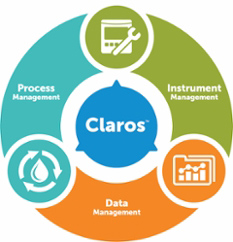-
Products
- Lab Instruments
- Lab Meters and Probes
- Chemistries, Reagents, and Standards
-
Online Analyzers
Ammonium Analysers Ammonia Monochloramine Chlorine Analyzers
- CL17sc
- CL10sc Amperometric
- 9184 sc Amperometric
- Ultra Low Range CL17sc Colorimetric Chlorine Analyser
EZ Series Analysers- Iron
- Aluminium
- Manganese
- Phosphate
- Chloride
- Cyanide
- Fluoride
- Sulphate
- Sulphide
- Arsenic
- Chromium
- Copper
- Nickel
- Zinc
- Ammonium
- Phenol
- Volatile Fatty Acids
- Alkalinity
- ATP
- Hardness
- Toxicity
- Sample Preconditioning
- Boron
- Colour
- Nitrate
- Nitrite
- Silica
- Hydrogen Peroxide
- EZ Series Reagents
- EZ Series Accessories
- EZ sc Series Inorganics
- EZ sc Series Metals
- EZ sc Series Nutrients
- Flow
-
Online Sensors and Controllers
Digital Controllers (Transmitters) Controllers (Analog)
- SC4500
- CA9300 Series Analog Transmitters
- Orbisphere 410/510 Carbon Dioxide
- Orbisphere 410/510 Oxygen
- Pro Series
pH & ORP Sensors- 12mm pH/ORP
- 8362 sc High Purity
- Combination pH/ORP
- Differential pH
- Digital Differential ORP
- Digital Differential pH
- LCP ORP
- LCP pH
- Sampling
- Multiparameter Online Panels
- Claros Water Intelligence System
- Test Kits & Strips
-
Microbiology
Prepared Media
- BARTS
- Liquid MPN
- MUG Tube
- Membrane Filtration
- Paddle Testers
- Presence-Absence
- Total Count Media
- Yeast and Mold
Dehydrated Media Kits Cryptosporidium & Giardia Analysis Legionella pneumophila Test Pseudomonas aeruginosa TestLabware- Accessories
- Funnels, Pumps & Manifolds
- Microbiology Filters
- Petri Dishes & Accessories
- Sampling Bags
- Vials, Tubes, Bottles & Racks
- Comparators
- Microbiology Accessories
- Microbiology Chemicals
- QC: Microbiology
- Quanti-Trays
- Sealer and Rubber Inserts
- UV Lamps
- Vessels
-
Lab Equipment and Supply
Apparatus
- Brushes
- Clamps, Rings & Stands
- Crucibles
- Crucibles & Casseroles
- Dispensers & Droppers
- Grab Samplers
- Oil and Grease
- Other Apparatus
- Pipet Aids
- Pipettes
- Racks
- Stir Bars
- Tubing
- Weighing Accessories
Instruments- Balances
- Hot Plates & Stirrers
- Microscopes
- Moisture Analysers
- Other Instruments
- Ovens & Incubators
- Thermometers
- Timers
- Vacuum Pump
- Automated Lab Systems
-
Environmental
Accessories Ambient Weather
- Kipp & Zonen Pyrgeometer
- Kipp & Zonen Scintillometer
- Lufft Ultrasonic Wind Sensor
- Lufft WS Series Smart Weather Sensor
- Lufft WS10 Series
Visibility and Present Weather Detection Hydrology Software Hydrology Water Discharge - Flow Road and Runway Sensors Solar Tracking and PV SoilingWater Level- OTT CBS Compact Bubbler Sensor
- OTT PLS Pressure Level Sensor
- OTT PLS(-C) Pressure Level Sensor with Conductivity
- OTT RLS Radar Level Sensor
- SUTRON Accubar Pressure Level Sensor
- SUTRON Constant Flow Bubbler
- SUTRON SDR Stage Discharge Recorder
Data Loggers and Telemetry- ADCON - Wireless Radio Communication / Telemetry
- Kipp & Zonen Data Logger
- SUTRON Antenna
- SUTRON SatLink 3 Logging Transmitter
- SUTRON XLINK 100 Logging Transmitter
- SUTRON XLINK 500 Logging Transmitter
- SUTRON XLite 9210 Datalogger
- SUTRON Xpert2 Datalogger
- Industrial UV
- Marine
- Municipal UV
- Parameters
- Applications
- Industries
- Brands
- Service & Support
- News & Events
Hach Malaysia
Choose your country or region:
Europe
Americas
Asia - Australasia
- Australia
- Mainland China
- India
- Indonesia
- Japan
- Malaysia
- New Zealand
- Philippines
- Singapore
- South Korea
- Thailand (Thai)
- Taiwan
- Vietnam
Middle East - Africa
Chemistries 603-2779 2080
Municipal Wastewater
Wastewater Treatment Processes – Doing More With Less
Each wastewater treatment plant is unique, with its own capacity, layout, processes and equipment, and effluent limits. And each plant is faced with rising energy and chemical costs, and regulations that change or become more stringent over time.
At Hach®, we embrace the challenge to continuously improve wastewater monitoring equipment and processes, including nutrient removal, aeration control, nitrification/denitrification, sludge dewatering, and other plant operations. Whether in primary, secondary, or tertiary treatment of wastewater, or in understanding solids handling, regulations, or the promise of a Water Intelligence System such as ClarosTM , Hach innovations and new applications can help you stay in compliance and reduce operating costs, doing more with less - with the confidence that your plant is running smoothly.

Wastewater Treatment Overview
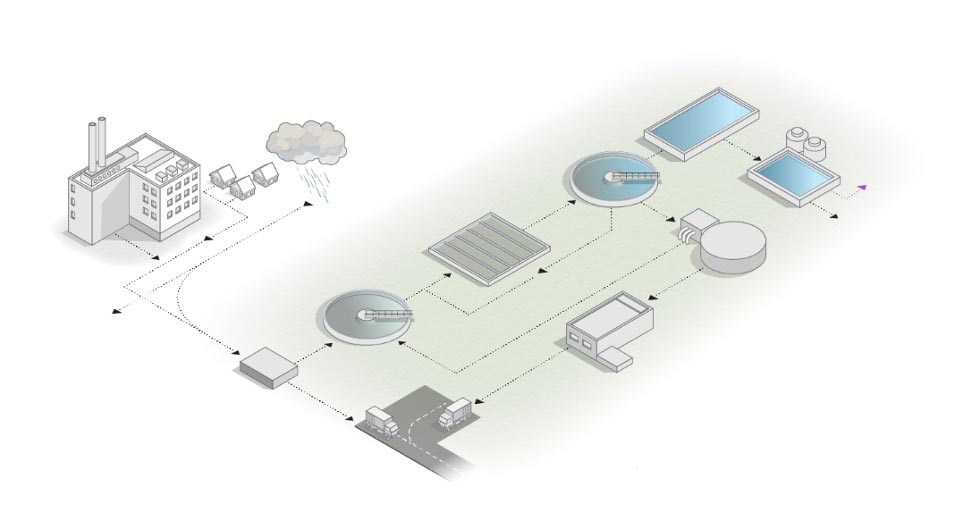
Collection Systems
Modern sanitary sewer collections systems move wastewater through a series of pipes from residential buildings, businesses, and industrial sites to wastewater treatment facilities for processing and discharge. Some older systems know as combined sewer systems also carry stormwater runoff in addition to the wastewater from residential and commercial sources.
The wastewater flows through underground sewer mains, most often by gravity, but sometimes assisted by pumps situated at lift stations. Depending on the topography of an area, these force mains vary in length up to a few miles long. Interceptors are locations where two lines meet and flow into a larger pipe, and can include large chambers accessible by manholes.
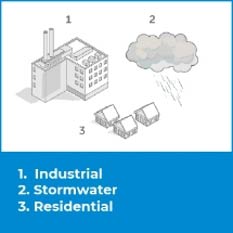
Preliminary and Primary Treatment
Preliminary treatment is typically the first process within the treatment
During primary treatment, primary clarifiers allow organic solids to settle through gravity, while fats, oils
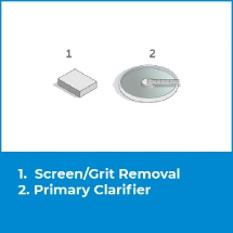
Secondary treatment
Secondary treatment removes the soluble organic matter, nutrients such as nitrogen and phosphorus, and most of the suspended solids that escape primary treatment. Most often, biological processes are used in which microbes metabolize organic compounds and nutrients to grow and reproduce. The two most common biological secondary treatment processes are
For biological treatment to function efficiently, organisms require nutrients in a balanced ratio, including carbon, nitrogen, and phosphorus (referenced as C:N:P), as well as trace elements including iron, copper, zinc, nickel, manganese, potassium, sulfur, and other components which are typically present in wastewater. The commonly accepted C:N:P Ratio is 100:5:1, although some facilities thrive outside of this ratio, while others experience polysaccharide slime formation or filamentous bacteria growth that inhibit the biology and settling in the secondary clarifier.
Multiple biological processes can be employed to complete secondary treatment, including plug flow aeration basins, complete mix aeration tanks, sequencing batch reactors, oxidation ditches, trickling filters, moving bed biological reactors, integrated
Biological Nutrient Removal (BNR) alters the environment of the microorganisms to remove nitrogen and phosphorus from the water. A BNR process consists of anaerobic (no oxygen or nitrate), anoxic (no oxygen, nitrate is present), and aerobic (oxygen present) stages, during which the water is moved through a series of chambers to perform various biological functions.
Chemical treatment processes can also be used, such as the chemical removal of phosphorus. By introducing a chemical precipitant to within the aeration basin and clarifiers, phosphorus is removed by flocculation, binding into insoluble compounds that settle out and can be removed as sludge.
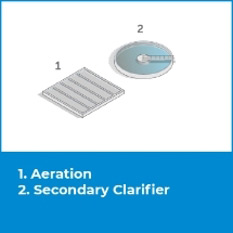
Application Specific Solutions
Nitrogen Removal:
Whether you are facing new regulations or trying to become more efficient, we can provide solutions for monitoring nitrate, dissolved oxygen, and other parameters that can save energy and chemical costs while optimizing nitrification and denitrification in your facility.
Learn more with Hach’s Nitrogen Removal Guide.Phosphorus Removal:
Whether you need a solution for chemical or energy savings, we can provide monitoring solutions that can save costs while optimizing your Phosphorus removal.
Learn more with Hach’s Phosphorus Removal Guide.Aeration Control:
If you are interested in lowering energy and maintenance costs, we have products with innovative luminescent technology to monitor dissolved oxygen and optimize your aeration control.
Learn more with Hach’s Aeration Control Guide.Dissolved Air Flotation (DAF) Optimization:
Does your facility
Tertiary Treatment
In tertiary treatment, techniques such as filtration, disinfection, carbon absorption, and other processes are used to remove the remaining organic load, suspended or dissolved solids, pathogens

Solids Handling
The method for handling the sludge removed from the process depends on the volume of solids as well as other site-specific conditions. Aerobic digestion is often used by facilities less than eight million gallons per day of inflow. Waste Activated Sludge and if present, Primary Sludge, are added to an aerated reactor where microorganisms feast on the organics and microorganisms present in the sludge to reduce the volatile solids content and the overall mass of sludge. Anaerobic digestion is typically used at facilities greater than eight million gallons per day of
Thickening involves concentrating the sludge by removing a percentage of the liquid portion by adding polymer
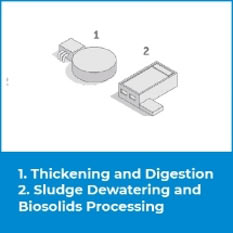
Water Intelligence
A growing field of expertise within the wastewater treatment industry, Water Intelligence Systems use digital technologies, advanced sensors, controllers, and algorithms to allow plant operators to increase efficiencies leading to overall cost savings in running the plant.
Claros™, the Water Intelligence System from Hach, integrates all plant data sources, including system data, device data, and manually-collected data, driving decisions to maximize efficiency and cost savings.
With these systems, data on flow rate, water composition, dissolved-oxygen, nutrient levels, and other factors are more easily tracked and verified. This leads to more responsive treatment options, automation capabilities, and data visualization and report generation.
Using data-driven insights into water quality, flow rate, and other factors, operators can reduce overtreatment (chemicals as well as aeration blower run time) while knowing their plant will remain within compliance limits.
As regulations become more stringent and plants need to find cost-savings, Water Intelligence Systems such as Claros will become more important and widely adopted. And with the Hach’s growing suite of Claros-Enabled sensors, controllers, devices, Process Management systems, and lab equipment, operators can configure a system that fits the unique requirements of any plant.
Regulations
Regulations and permit limits vary from region to region and country to country. Generally, target limits are established by the acting authority, and plants measure and report to demonstrate compliance with established limits. In this way, important parameters that indicate water quality and environmental and health standards are monitored and maintained, ensuring the continued health and safety of the populations being served.
For information regarding regulations in the US: https://www.epa.gov/npdes
For information regarding regulations in the EU: https://www.eea.europa.eu/themes/water/water-management
For information regarding regulations in
Effluent & Reuse
While effluent from wastewater treatment facilities is commonly discharged to the environment in rivers, oceans, or other bodies of water, there are a variety of other options for discharge. These include agricultural irrigation; use in parks and recreational facilities (golf courses and sports field irrigation); wildlife habitat or aquifer/wetland/marsh recharging; industrial uses such as process water; street cleaning; or direct potable reuse where water is sent to a drinking water plant for further treatment.
PRODUCT SUPPORT
CUSTOMER SERVICE
RESOURCES
ABOUT US
Looking for our Hach US Site?
It appears that you are visiting Hach from the United States but the site you are currently visiting is for Malaysia.
Would you like to visit the Hach US site instead?




